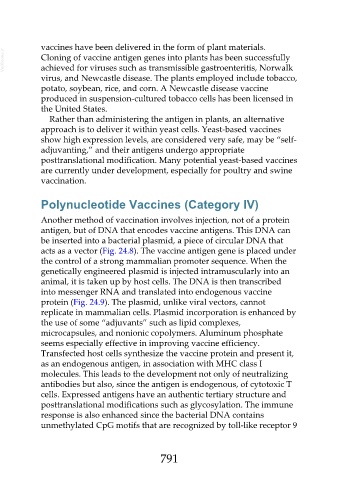Page 791 - Veterinary Immunology, 10th Edition
P. 791
vaccines have been delivered in the form of plant materials.
VetBooks.ir Cloning of vaccine antigen genes into plants has been successfully
achieved for viruses such as transmissible gastroenteritis, Norwalk
virus, and Newcastle disease. The plants employed include tobacco,
potato, soybean, rice, and corn. A Newcastle disease vaccine
produced in suspension-cultured tobacco cells has been licensed in
the United States.
Rather than administering the antigen in plants, an alternative
approach is to deliver it within yeast cells. Yeast-based vaccines
show high expression levels, are considered very safe, may be “self-
adjuvanting,” and their antigens undergo appropriate
posttranslational modification. Many potential yeast-based vaccines
are currently under development, especially for poultry and swine
vaccination.
Polynucleotide Vaccines (Category IV)
Another method of vaccination involves injection, not of a protein
antigen, but of DNA that encodes vaccine antigens. This DNA can
be inserted into a bacterial plasmid, a piece of circular DNA that
acts as a vector (Fig. 24.8). The vaccine antigen gene is placed under
the control of a strong mammalian promoter sequence. When the
genetically engineered plasmid is injected intramuscularly into an
animal, it is taken up by host cells. The DNA is then transcribed
into messenger RNA and translated into endogenous vaccine
protein (Fig. 24.9). The plasmid, unlike viral vectors, cannot
replicate in mammalian cells. Plasmid incorporation is enhanced by
the use of some “adjuvants” such as lipid complexes,
microcapsules, and nonionic copolymers. Aluminum phosphate
seems especially effective in improving vaccine efficiency.
Transfected host cells synthesize the vaccine protein and present it,
as an endogenous antigen, in association with MHC class I
molecules. This leads to the development not only of neutralizing
antibodies but also, since the antigen is endogenous, of cytotoxic T
cells. Expressed antigens have an authentic tertiary structure and
posttranslational modifications such as glycosylation. The immune
response is also enhanced since the bacterial DNA contains
unmethylated CpG motifs that are recognized by toll-like receptor 9
791

